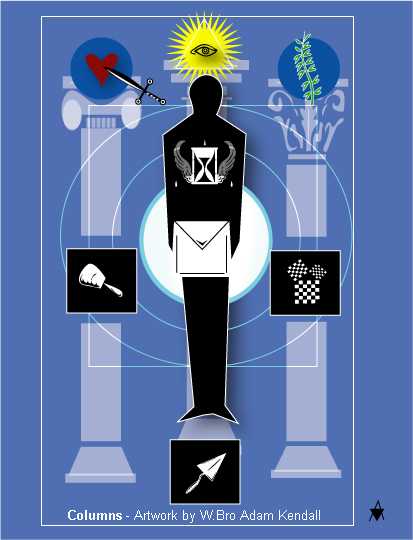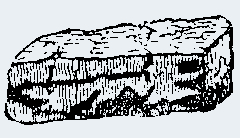|
Part
One: An Introduction to Masonic
Aestheticism
The
intent and action of the individual
will that compels one to enter the portals of Freemasonry and the ongoing
process by which one shapes himself as such is a common theme throughout the
tradition. It is illustrated by the
symbolism and allegory of the craftsman's aesthetics,
which is defined as a branch of philosophy dealing with the nature, creation,
and appreciation of beauty. Indeed,
the whole of the Masonic mythos is said to impart into the initiate the creative
skills of ancient temple builders in order that their speculative discipline
blossoms into self-exploration. Hence
the symbology, ritual drama (or allegory), jargon and (especially) the common
origins Masonic history—both of ancestral builders and medieval architects and
workers of stone, mortar and metal-- is the central theme of the instructional
dramas that comprise Ancient Craft Freemasonry.
It
has been my personal observation as an artist, that the method of teaching
embodies a systematic ritualized illustration of real aesthetic principals derived from a
mythological operative past. The
path of the aesthete, an admirer of
aesthetic principles, is not limited to only artisans, but to all people good
and true who are interested in the key precepts of Wisdom, Strength and Beauty.
Freemasonry’s ingenious and layers-deep system of rectitude and
self-knowledge teaches, at its core, that an individual can build and lead their
lives as if it were metaphorically a beautiful, strong edifice—shaped with
skill, but, alas, not without the least effort or exertion of regulated force
and restraint. Herein lays the
necessity of training a technique that requires a natural predisposition to a
creative and rational mindset. Were this philosophy devoid of appreciation for the
supra-conscious and spiritual part of man, it would be rigid and devoid of the
mechanics that encourage the development of creative possibilities.
Conversely, if it was purely creative for its own sake, the effort would
be deemed unfocused, no matter what the design. For
the arts in all of their forms: the scientific; the medical; the architectural,
and the Fine; all combine formula, intellect, logic, and reason with mercurial
intuition and creativity. These professional arts are also are dependent upon
each other-- for many buildings would never be erected without the metallurgist
or other scientists, such as an engineer or seismologist to determine the finer
points of the building’s structure and its relationship to the earth on which
it sits. Moreover, none of them can
be expressed without the skills of the fine artist who may draw the anatomy of a
building or a body to use as a map for the architect or surgeon. In fine, aestheticism
is the ideal by which all skills of the human being may unite to create a work
of art in perfect harmony. This is
a very important point when considering the unity and interdependence in nature.
Intent
and action must be balanced in order to reach its
goal--which is to create something, as mentioned before, balanced and perfect.
However, the end result is not the finality; the process of its creation
determines its perfection. Therefore
to the aesthete, the process of understanding the path and the way one may
affect the unfolding of its becoming, lies in the patient acquiring and exercise
of skill-- which is the harmony of intent and action.

Part
Two—The Rough and Perfect Ashlars
In
Freemasonry, one set of symbols that exemplify the aesthetic principles of
determining and evoking the potential in art and livelihood is the Rough and
Perfect Ashlars. They are a class of symbols surprisingly overlooked in some
jurisdictions, which seems strange considering Freemasonry concerns itself with
the very subject of building in stone! It
is a class of symbols whose equation and sum have an important mention in all
degrees of the Craft Lodge, primarily in the Entered Apprentice, the Fellow
Craft; but also within the degrees of Mark Master Mason and the Royal Arch.
The ashlars are actual objects to be shaped and fit by the stonemason,
just as they are symbols of the aesthetic process of creation, which includes at
every point the balance of technical skill of every successive degree or level
of understanding. By shaping the
ashlar from a state of roughness (that is, pure potential) to something
beautiful and potential manifest—not just merely useful-- the intent
and action of its creator’s intellect and creativity may be determined.
 The
Rough Ashlar is a rough stone cut and raised from the quarries by the
Apprentices under the supervision and experience of the Fellowcrafts and the
watchful eye of the overseers, or Masters, and is thus explained by the Bro.
Johann Christian Gadicke in his Lexicon of
Freemasonry:
The
Rough Ashlar is a rough stone cut and raised from the quarries by the
Apprentices under the supervision and experience of the Fellowcrafts and the
watchful eye of the overseers, or Masters, and is thus explained by the Bro.
Johann Christian Gadicke in his Lexicon of
Freemasonry:
“We
cannot regard the rough ashlar as an imperfect thing, for it was created by the
Almighty Great Architect and he created nothing imperfect, but gave us wisdom
and understanding, so as to enable us to convert the seemingly imperfect to our
especial use and comfort. What
great alterations are made in a rough ashlar by mallet and chisel!
With it are formed, by the intelligent man, the most admirable pieces of
architecture. And man, what is he
when he first enters into the world? —Imperfect, and yet a perfect work of
God, out of which so much can be made by education and cultivation.”
Notice
the mention of the tools of the first degree—the mallet, (the common gavel),
and the chisel (which is not included in California Preston-Webb ritual for the
Entered Apprentice, but exists in various English and Continental European
workings). Indeed, this chisel
should be considered a very important tool even in our Preston-Webb work, in
relation to the 24-inch gauge—for both are the handmaidens of the gavel
without which it would be a mere instrument of force. By a regulated blow from
the mallet (or gavel), with the guidance of measurements set by the gauge, the
chisel may make its cuts made by the skilled craftsman.
From the use of skill and intelligence as stated by Gadicke one can
deduce how these tools would be helpful. Meditation
and thought on these symbols are required by the speculative craftsman so as to
derive the beautiful allegory of their use in order to give a place in one's
personal mythology.
Consider
the definition by Robert Macoy of the Perfect Ashlar which has become a perfect,
squared stone that symbolizes our unconscious and conscious essence fitted for
the builder’s use in “that house made not with human hands”:
 “The
Perfect Ashlar is a stone of a true square, which can only be tried by the
square and compasses. This
represents the mind of a man at the close of life, after a well-regulated career
of piety and virtue, which can only be tried by the square of God’s Word, and
the compasses of an approving conscience.”
“The
Perfect Ashlar is a stone of a true square, which can only be tried by the
square and compasses. This
represents the mind of a man at the close of life, after a well-regulated career
of piety and virtue, which can only be tried by the square of God’s Word, and
the compasses of an approving conscience.”
As
per Macoy, it would seem that the perfection of the ashlar is a result of
applying the aesthetic principal that will draw forth the stone's true beauty by
first recognizing its inherent goodness and perfection, and by peeling
away the layers to expose its inner nature. This unveiling of true potential
is made manifest by a long and sometimes arduous road; the process requires
knowledge coupled with knowledge intuition or faith, that is, creativity. The speculative mason learns the manner by which his
technique and creativity combined and perfected through degrees or equations
assist him in developing latent creative powers.
Today
in California lodges are re-adopting the use of the ashlars and placing them
side by side in the East. A number
of traditions, particularly on the European Continent, also accord both ashlars
an important place in the East, but with interesting differences in their
arrangement, which alludes to their purpose in ritual-- of whose definition we
can clearly benefit. In some German
Masonic rituals, for example, the rough is situated on the first step to the
dais of the Worshipful Master. The
perfect ashlar is placed on the second step, which symbolizes its relationship
with the duties and tasks of the Fellow Craft--to use the perfected stone as a
measure by which his tools are trued. If
one follows the second degree in the American rituals, the same deduction can be
made.
It
is by the hewing of the rough stone to its smooth and perfected state so it may
fit perfectly in the building, and that by it all tools may be trued and kept
aright for continued use in our lifetimes.
Thus, this perfect stone becomes to our speculative profession a symbol
of the greatness of the virtue that was born from the rough state by the skilled
determination of the craftsman to its true potential as a useful part of the
whole.
By
considering this beautiful class of symbols interdependent with the working
tools of every degree in Freemasonry, one may begin to develop a deeper attitude
in regard to our Craft: recognition of the aesthetic approach is necessary in
order to properly develop the skill in one's life.
The aesthetic principal lends to skill a particular quality of
personality--without which a proper development of our character would be
impossible, or at least produce flawed and unfeeling traits in the individual.
Embracing aesthetic beauty creates for the Freemason level foundations of
an enlightened and intelligent morality by which one will stray to no extreme,
but rather walk softly on a path of balance and mildness.
On
this path, the interplay of force and support combine to hold the frame aloft. Using faith combined with ingenuity, creativity, and the
willingness to go further, one can utilize this symmetry to create one’s own
life into a temple. This
evolutionary process is embodied in the definition of beauty. Thus, perhaps it can be said that beauty is eternal and ever
unfolding, as is our knowledge of what is Divine. This is aestheticism as practiced by all artists and brought
forth by the knowledge of their craft.
|
![]() News Feed |
News Feed |  Subscribe News by Email
Subscribe News by Email